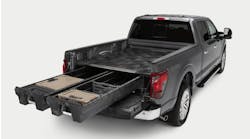Latest from Hydronics & Radiant
Sponsored
BY ROBERT P. MADER Of CONTRACTOR’s staff
TRENTON, N.J. — The long legal battle between Goodyear Tire & Rubber Co. and Heatway over Entran II hydronic radiant tubing is not over yet.
A U.S. District Court judge in New Jersey has certified a national class and conditionally approved a $236 million settlement between Goodyear and owners and former owners of property where Entran II radiant heating or snow-melting hose was installed.
That does not mean, however, that the case is settled. Not by a long shot. Disputes among Goodyear, lawyers and homeowners in Colorado, New Mexico and New England could go on for years.
But first, let’s consider the settlement that Goodyear has announced.
Goodyear has agreed to contribute $76 million to a settlement fund over the next five years and could add a total of $40 million in contingency payments, if certain company financial performance goals are met, during 2004 through 2007. The settlement is conditional on the receipt of certain insurance proceeds and adequate property owner participation.
Goodyear expects the plaintiffs’ attorneys to seek similar approval of the class settlement in Canadian courts in the near future. Property owners in six New England states are not part of the settlement class.
The proposed settlement does not include property owners with jury verdicts under appeal by Goodyear. The national settlement class may or may not include property owners in Colorado and New Mexico. A Colorado state court judge has temporarily prevented Goodyear from taking any further steps that would affect the rights of Colorado property owners. A similar motion, filed in a state court on behalf of New Mexico property owners, is pending.
Goodyear supplied the hose product from 1989 to 1993 to Chiles Power Supply Inc., d/b/a Heatway Systems and now the Watts Radiant division of Watts Water Technologies.
At first glance, it looks as if Goodyear has reached a national settlement that will rid it of all outstanding Entran II claims. In actuality, it has not.
The first issue is that Goodyear announced a $236 million settlement and said it will contribute $76 million. Another $120 million has to come from Goodyear’s insurance companies and that payment is not a sure thing. If the insurers don’t come up with $120 million, Goodyear has to decide if it wants to make up the difference out of its own pocket.
Goodyear has until the end of February to line up the insurance money, said William Maywort of the Denver law firm Holland & Hart. Maywort has been an opponent of Goodyear in courts in Colorado and New Mexico. Unless and until the insurance money is in the bank, the settlement cannot move forward, Maywort said.
The $40 million in contingent payments, $10 million a year, scheduled to be made from 2004 through 2007, depends on whether Goodyear hits its EBITDA targets. The target is $1.2 billion in 2004 and $1.4 billion each year thereafter.
Because that $40 million depends on future events, said Maywort’s partner Lee Gray, the only money that Goodyear has agreed to is $196 million.
Goodyear’s national settlement may not be nationwide at all. Goodyear and the plaintiffs’ attorneys, with whom it was negotiating, attempted to bring six New England states into the settlement.
No deal, said U.S. District Judge Nancy Gertner in Boston. Payne v. Goodyear had been filed in federal district court in Boston in 2001. Gertner ruled that Goodyear could not come to a settlement without the direct involvement of the New England class and its lawyers. Consequently, plaintiffs in Massachusetts, New Hampshire, Maine, Vermont, Connecticut and Rhode Island are specifically excluded from the settlement in New Jersey Federal Court.
It is similarly uncertain if the settlement will include plaintiffs in Colorado and New Mexico. Class actions against Goodyear have been certified in those states, but in state courts, not federal court. The New Jersey Federal Court may claim jurisdiction over the Colorado and New Mexico cases, but there again, it depends.
The judge in Trenton, U.S. District Judge Stanley R. Chesler, has said that he will follow a federal court precedent on class-action suits. The precedent, in Zahn v. International Paper, says that federal courts do not have jurisdiction over class-action suits unless every single member of the class has damages of more than $75,000. Maywort and Gray are going to scour New Jersey looking for a plaintiff with less than $75,000 in damages. If they can find one, Chesler will remand the case to New Jersey state court and the cases in Colorado and New Mexico will go on.
If class-action suits in Colorado, New Mexico and New England are not included, the settlement will collapse — most of the Entran II tubing installed will be out of the settlement.
Of 25 million lineal ft. of Entran II tubing produced, 4.8 million ft. were installed in Colorado, 3.7 million ft. in New Mexico, and 4.7 million ft. are in the six New England states. That would mean that 60% of the tubing would not be included in the settlement.
Even if the settlement goes forward, homeowners can opt out, and Colorado and New Mexico homeowners may choose to opt out. As it stands, the $196 million is not a great settlement.
Goodyear and the lead attorney for the plaintiffs, the Washington law firm Cuneo Waldman & Gilbert, have agreed to 30% attorney’s fees. That’s $58.8 million in attorney’s fees, taking the settlement down to $137.2 million.
Then the parties have agreed to appoint a special master to determine how the money is going to be paid to plaintiffs. Gray estimates it will cost $10 million to run the special master’s office. That brings the settlement down to $127.2 million. Divide that by the thousands of homeowners that might make claims, and homeowners may not get enough to repair their damages. Plus they might not get money unless they have an active leak.
If too many homeowners opt out of the settlement, Goodyear has the option of scrapping the whole deal, an outcome that’s conceivable.

